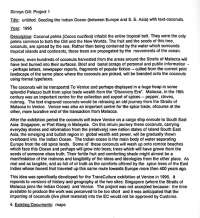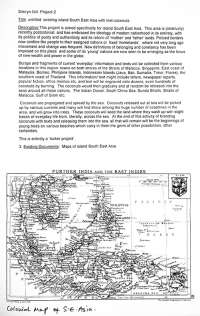Project 1
Title: untitled. Seeding the Indian Ocean (between Europe and S. E. Asia) with text-coconuts.
Year: 1995
Description: Coconut palms (Cocos nucifera) inhabit the entire tropical belt. They were the only palms common to both the Old and the New Worlds. The fruit and the seeds of this tree, coconuts, are spread by the sea. Rather then being contained by the water which surrounds tropical islands and continents, these trees are propagated by the movements of the ocean.
Dozens, even hundreds of coconuts harvested from the areas around the Straits of Malacca will have text burned into their surfaces. Brief and banal scraps of personal and public information - - perhaps letters, newspaper reports, fragments of popular fiction - culled from the current print landscape of the same place where the coconuts are picked, will be branded onto the coconuts using formal typefaces.
The coconuts will be transported To Venice and perhaps displayed in a huge heap in some splendid Palazzo built from spice trade wealth from the "Discovery Era." Malacca, in the 16th century was an important centre for the collection and export of spices -- pepper, cloves, nutmeg. The text engraved coconuts would be retracing an old journey from the Straits of Malacca to Venice. Venice was also an important centre for the spice trade, of course at the other, more lucrative end of the transaction from Malacca.
After the exhibition period the coconuts will leave Venice on a cargo ship enroute to South East Asia: Singapore, or Port Klang in Malaysia. On this return journey these coconuts, carrying everyday stories and information from the (relatively) new nation states of Island South East Asia, the emerging and bullish region in global wealth and power, will be gradually thrown overboard into the Indian Ocean. The Indian ocean is the main body of water separating Europe from the old spice lands. Same of these coconuts will wash up onto remote beaches which face this Ocean and perhaps will grow into trees; trees which will have grown from the seeds of someone else's truth. Their fertile fruit and comforting shade might almost be a manifestation of the realness and tangibility of the ideas and ideologies from the other place. As real and as tangible, and as full of of truth as the comforts offered by the spice trees of the East lndies whose honest fruit traveled up this same route towards Europe more then 400 years ago.
This idea was specifically developed for the TransCulture exhibition at Venice in 1995. lt responds to versions of history and geography at the two sites: Singapore (where the Straits of Malacca joins the Indian Ocean) and Venice. The project was not accepted because: the time available to produce the work was perceived to be too short and it was anticipated that the importing of coconuts (live plant material) into the EC would not be approved by Customs.
Existing Documents: Maps
Project 2
Title: untitled: seeding island South East Asia with text-coconuts
Description: This project is aimed specifically for island South East Asia. This area is (relatively) recently postcolonial, and has embraced the ideology of modern nationhood in its entirety, with its politics of purity and authenticity and its rhetoric of 'mother' and 'father' lands. Policed borders now confine the people to their assigned nations or fixed 'homelands', where not very long ago movement and change was frequent. New definitions of belonging and constancy has been imposed on this place and some of its 'young' nations are now seen to be emerging as the focus of new wealth and power in the globe.
Scraps and fragments of current 'everyday' information and texts will be collected from various locations in this region: towns on both shores of the Straits of Malacca, Singapore, East coast of Malaysia, Borneo, Phillipine Islands, Indonesian Islands (Java, Bali, Sumatra, Timor, Flores), the southern coast of Thailand . This information/text might include letters, newspaper reports, popular fiction, office memos etc. and text will be engraved onto dozens, even hundreds of coconuts by burning. The coconuts would then gradually and at random be released into the seas around all these nations. The Indian Ocean, South China Sea, Sunda Straits. Straits of Malacca, Gulf of Siam etc.
Coconuts are propagated and spread by the sea. Coconuts released out at sea will be picked up by various currents and many will find shore among the huge number of coastlines in the area, and wil grow into trees. These coconuts will seed the land where they wash up with slight traces of everyday life from, literally, across the sea. At the end of this activity of branding coconuts with texts and releasing them into the sea, all that will remain will be the beginnings of young trees on various beaches which carry in them the germ of other possibilities, other certainties.
This is entirely a 'locker project'.
Existing Documents: Maps of island South East Asia
Project 1
Title: untitled. Seeding the Indian Ocean (between Europe and S. E. Asia) with text-coconuts.
Year: 1995
Description: Coconut palms (Cocos nucifera) inhabit the entire tropical belt. They were the only palms common to both the Old and the New Worlds. The fruit and the seeds of this tree, coconuts, are spread by the sea. Rather then being contained by the water which surrounds tropical islands and continents, these trees are propagated by the movements of the ocean.
Dozens, even hundreds of coconuts harvested from the areas around the Straits of Malacca will have text burned into their surfaces. Brief and banal scraps of personal and public information - - perhaps letters, newspaper reports, fragments of popular fiction - culled from the current print landscape of the same place where the coconuts are picked, will be branded onto the coconuts using formal typefaces.
The coconuts will be transported To Venice and perhaps displayed in a huge heap in some splendid Palazzo built from spice trade wealth from the "Discovery Era." Malacca, in the 16th century was an important centre for the collection and export of spices -- pepper, cloves, nutmeg. The text engraved coconuts would be retracing an old journey from the Straits of Malacca to Venice. Venice was also an important centre for the spice trade, of course at the other, more lucrative end of the transaction from Malacca.
After the exhibition period the coconuts will leave Venice on a cargo ship enroute to South East Asia: Singapore, or Port Klang in Malaysia. On this return journey these coconuts, carrying everyday stories and information from the (relatively) new nation states of Island South East Asia, the emerging and bullish region in global wealth and power, will be gradually thrown overboard into the Indian Ocean. The Indian ocean is the main body of water separating Europe from the old spice lands. Same of these coconuts will wash up onto remote beaches which face this Ocean and perhaps will grow into trees; trees which will have grown from the seeds of someone else's truth. Their fertile fruit and comforting shade might almost be a manifestation of the realness and tangibility of the ideas and ideologies from the other place. As real and as tangible, and as full of of truth as the comforts offered by the spice trees of the East lndies whose honest fruit traveled up this same route towards Europe more then 400 years ago.
This idea was specifically developed for the TransCulture exhibition at Venice in 1995. lt responds to versions of history and geography at the two sites: Singapore (where the Straits of Malacca joins the Indian Ocean) and Venice. The project was not accepted because: the time available to produce the work was perceived to be too short and it was anticipated that the importing of coconuts (live plant material) into the EC would not be approved by Customs.
Existing Documents: Maps
Project 2
Title: untitled: seeding island South East Asia with text-coconuts
Description: This project is aimed specifically for island South East Asia. This area is (relatively) recently postcolonial, and has embraced the ideology of modern nationhood in its entirety, with its politics of purity and authenticity and its rhetoric of 'mother' and 'father' lands. Policed borders now confine the people to their assigned nations or fixed 'homelands', where not very long ago movement and change was frequent. New definitions of belonging and constancy has been imposed on this place and some of its 'young' nations are now seen to be emerging as the focus of new wealth and power in the globe.
Scraps and fragments of current 'everyday' information and texts will be collected from various locations in this region: towns on both shores of the Straits of Malacca, Singapore, East coast of Malaysia, Borneo, Phillipine Islands, Indonesian Islands (Java, Bali, Sumatra, Timor, Flores), the southern coast of Thailand . This information/text might include letters, newspaper reports, popular fiction, office memos etc. and text will be engraved onto dozens, even hundreds of coconuts by burning. The coconuts would then gradually and at random be released into the seas around all these nations. The Indian Ocean, South China Sea, Sunda Straits. Straits of Malacca, Gulf of Siam etc.
Coconuts are propagated and spread by the sea. Coconuts released out at sea will be picked up by various currents and many will find shore among the huge number of coastlines in the area, and wil grow into trees. These coconuts will seed the land where they wash up with slight traces of everyday life from, literally, across the sea. At the end of this activity of branding coconuts with texts and releasing them into the sea, all that will remain will be the beginnings of young trees on various beaches which carry in them the germ of other possibilities, other certainties.
This is entirely a 'locker project'.
Existing Documents: Maps of island South East Asia

